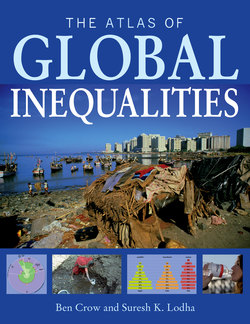Читать книгу The Atlas of Global Inequalities - Ben Crow - Страница 15
На сайте Литреса книга снята с продажи.
ОглавлениеEconomic Inequalities
R Economic differences are the most common focus of study and comment, partly because they are most easily measured. They are given prominence at the beginning of this atlas, however, because they are a major underlying driver of many of the social inequalities covered in the rest of the book. The wealthiest tenth of the global population receives 58 percent of annual incomes, and owns 71 percent of household wealth – assets, property and capital. And while the average income of the richest decile is 94 times that of the poorest, the ratio between the average household wealth of the richest and poorest deciles is an almost unimaginable 175,750:1. Redressing the negative effects of income and wealth inequality is complicated, not least because the social processes involved in raising productivity and living standards also create inequalities. The global system of capitalism has been successful in harnessing technical and social innovation to generate increased productivity. This has enabled higher living standards, notably in the industrial countries but much less so in the developing world. This uneven pattern of industrialization is the main reason why income inequality between countries rose from about 3:1 in 1800 to 72:1 in 1992. Capitalism also generates inequalities within countries, giving some great wealth, others meager wages, and still others unemployment. Although some parts of Europe have less income inequality than the USA or Brazil, the extent to which capitalism is compatible with economic equality is debatable. Capitalism operates through the accumulation of wealth in the hands of a few – a process that is speeded by low wages and unemployment. Currently, 2 percent of the world’s population owns half the world’s wealth. Huge armies of the poor face insecurity and low returns in the informal sector in Asia, Africa and Latin America. The processes of accumulation and exploitation interact with many other causes of inequality, including exclusions such as racism, to create diverse patterns of wealth, consumption, work, and unemployment. In turn, these inequalities constrain many individual freedoms and capabilities. The rich, to give an obvious example, have command over magnificent homes, art, culture, beauty, and much else besides, while most of the poor cannot keep their food cold. Economic inequality can be reduced through labor migration, although barriers to mobility are especially high for poor people, and people with low skills, despite the demand for their labor in many rich countries. Sadly, forces of exclusion, such as racism and nationalism, stand in the way of the equalizing potential of migration. All rich countries have erected barriers against people crossing borders to seek work.
15
Copyright © Myriad Editions
